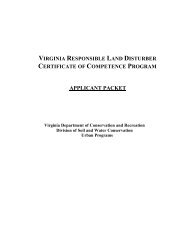Dameron Marsh NAP self-guided field trip guide - Virginia ...
Dameron Marsh NAP self-guided field trip guide - Virginia ...
Dameron Marsh NAP self-guided field trip guide - Virginia ...
Create successful ePaper yourself
Turn your PDF publications into a flip-book with our unique Google optimized e-Paper software.
Stop 2...<br />
The area’s geology:<br />
• 120,000 years ago the sea level was 15-25 feet higher that it is today.<br />
• 18,000 years ago if you looked east you would see a broad canyon containing the ancestral Susquehanna River.<br />
• Sea level continues to rise about 2mm a year.<br />
• The shore line of <strong>Dameron</strong> <strong>Marsh</strong> is eroding at a rate of about 8—10 feet a year. There were once three islands off<br />
the tip of the marsh (Carters Filer’s father promised to give her those islands when she was a little girl!) that are now<br />
gone. Since 1937 - 250 feet have been lost from the shoreline and sea level rose nearly 2 feet in that time.<br />
• Previous landowners drained these <strong>field</strong>s and this led to belts of different vegetation reflect the response of plants to<br />
changes in thickness of the unsaturated zone ( the zone between the land surface and the water table) and the frequency<br />
of flooding after rains. In some of the deeper ditches cat-tails have established themselves and are indicators<br />
not only of a wetland but of the salinity of the water. The Narrow-leaved Cat Tail that you can see from here is<br />
more tolerant of salt water than the Common Cat tail.<br />
• Look for Narrow -leaved Cat tails, Partridge Pea (will be in fruit on later <strong>trip</strong>s), High Tide Bush in bloom, and<br />
Broomsedge (remember that it is not a sedge—that is a misnomer—it is really a grass).<br />
Seaside Goldenrod<br />
Solidago sempervirons<br />
Cattails are behind the switchgrass—rather<br />
hard to see this year —a good lead in for<br />
old <strong>field</strong> succession and how much everything<br />
has changed in just a few years...<br />
Wax Myrtle<br />
Morella cerifera<br />
Partidge pea<br />
Cassia facisiculata<br />
(Formerly Chamaecrista)<br />
Broom sedge<br />
Andropogon virginicus
















